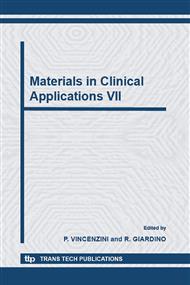p.56
p.62
p.68
p.74
p.79
p.85
p.91
p.97
p.103
Nanostructured Carbon Films Produced by Pulsed Laser Deposition for Bio-Medical Applications
Abstract:
Damond-like (DLC) films can be produced by Pulsed Laser Deposition (PLD) technique. Different pulsed lasers can be employed to generate hot carbon plasma, to deposit and/or to implant energetic carbon atoms and molecules on substrates. A Nd:Yag laser radiation with ns pulse duration, about 1010 W/cm2intensity and 30 Hz repetition rate, can be employed to produce in vacuum thin carbon films with properties similar to graphite and diamond. The films were deposited on SiO2 substrates, placed at different distances and angles from the target. The PLDgenerated plasma can be controlled “in situ” by mass quadrupole spectroscopy and time-of-flight tehniques. “Ex situ” investigations were performed on the deposited films by using the Scanning Electron Microscopy (SEM) and Raman spectroscopy. Deposited films show evidence of carbon nanostructures, which find a growing variety of applications in medicine and bio-enegineering fields. Diamond-like carbon (DLC) shows low friction, high atomic density, hard but flexible structure, chemical inertia, wear, diffusion and corrosion resistance and highly bio and hemocompatible properties.
Info:
Periodical:
Pages:
79-84
Citation:
Online since:
October 2006
Authors:
Price:
Сopyright:
© 2006 Trans Tech Publications Ltd. All Rights Reserved
Share:
Citation:


